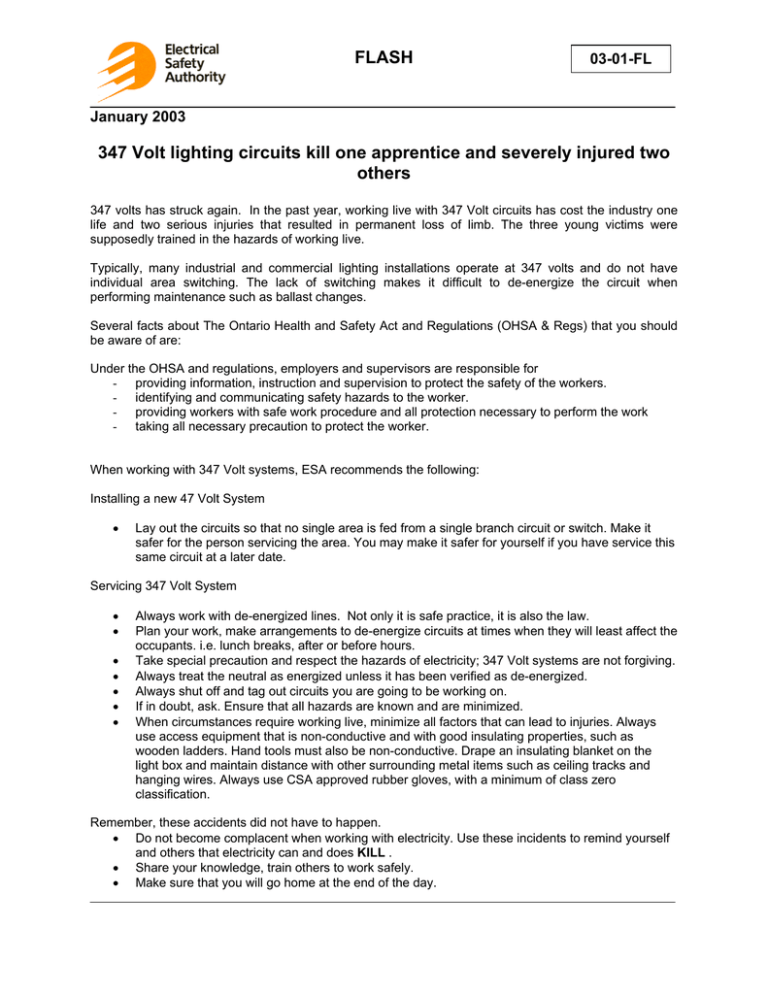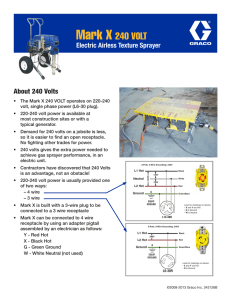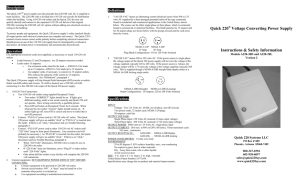347 Volt Lighting Safety: Prevention & Regulations
advertisement

FLASH 03-01-FL January 2003 347 Volt lighting circuits kill one apprentice and severely injured two others 347 volts has struck again. In the past year, working live with 347 Volt circuits has cost the industry one life and two serious injuries that resulted in permanent loss of limb. The three young victims were supposedly trained in the hazards of working live. Typically, many industrial and commercial lighting installations operate at 347 volts and do not have individual area switching. The lack of switching makes it difficult to de-energize the circuit when performing maintenance such as ballast changes. Several facts about The Ontario Health and Safety Act and Regulations (OHSA & Regs) that you should be aware of are: Under the OHSA and regulations, employers and supervisors are responsible for - providing information, instruction and supervision to protect the safety of the workers. - identifying and communicating safety hazards to the worker. - providing workers with safe work procedure and all protection necessary to perform the work - taking all necessary precaution to protect the worker. When working with 347 Volt systems, ESA recommends the following: Installing a new 47 Volt System • Lay out the circuits so that no single area is fed from a single branch circuit or switch. Make it safer for the person servicing the area. You may make it safer for yourself if you have service this same circuit at a later date. Servicing 347 Volt System • • • • • • • Always work with de-energized lines. Not only it is safe practice, it is also the law. Plan your work, make arrangements to de-energize circuits at times when they will least affect the occupants. i.e. lunch breaks, after or before hours. Take special precaution and respect the hazards of electricity; 347 Volt systems are not forgiving. Always treat the neutral as energized unless it has been verified as de-energized. Always shut off and tag out circuits you are going to be working on. If in doubt, ask. Ensure that all hazards are known and are minimized. When circumstances require working live, minimize all factors that can lead to injuries. Always use access equipment that is non-conductive and with good insulating properties, such as wooden ladders. Hand tools must also be non-conductive. Drape an insulating blanket on the light box and maintain distance with other surrounding metal items such as ceiling tracks and hanging wires. Always use CSA approved rubber gloves, with a minimum of class zero classification. Remember, these accidents did not have to happen. • Do not become complacent when working with electricity. Use these incidents to remind yourself and others that electricity can and does KILL . • Share your knowledge, train others to work safely. • Make sure that you will go home at the end of the day.




